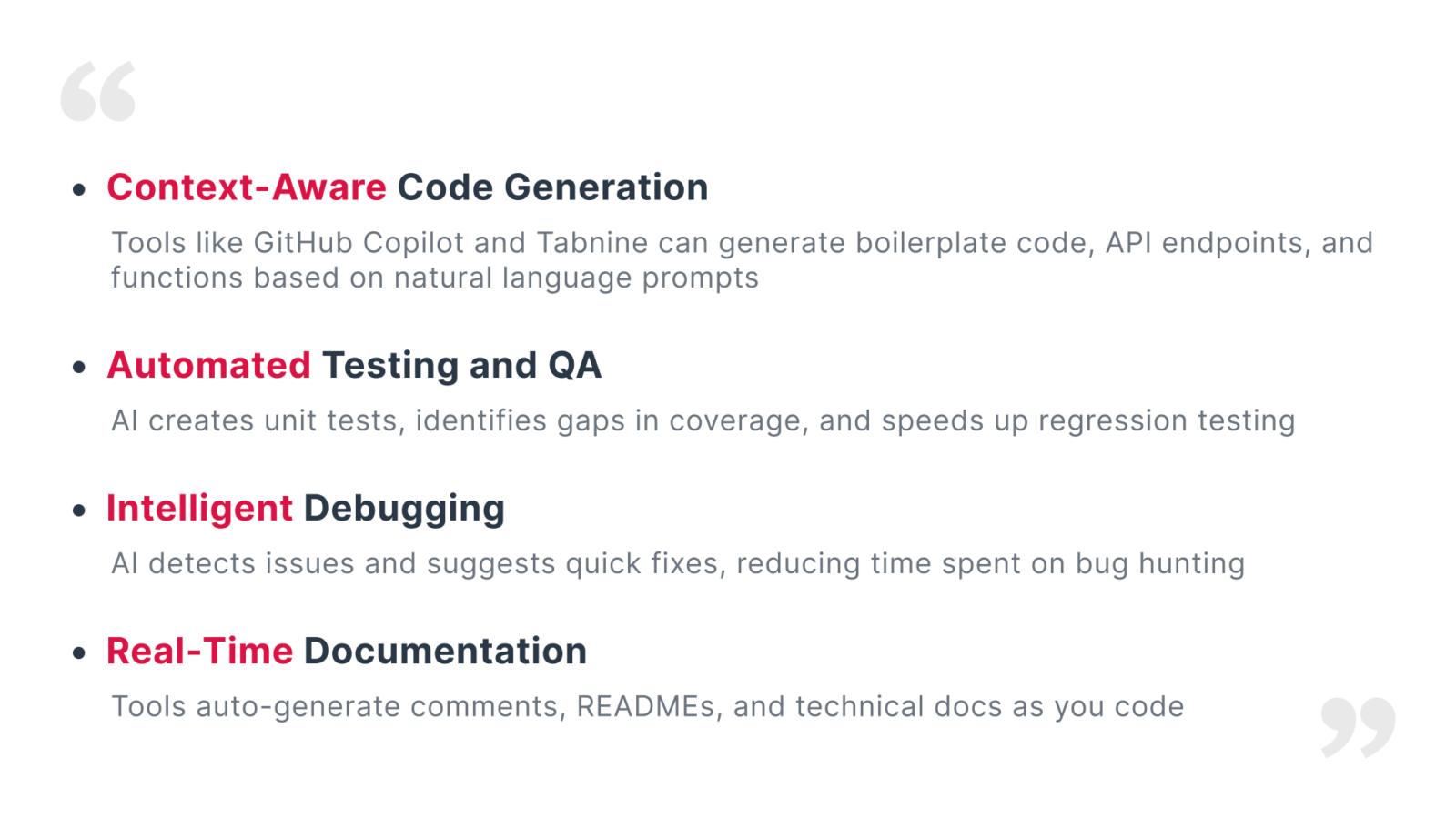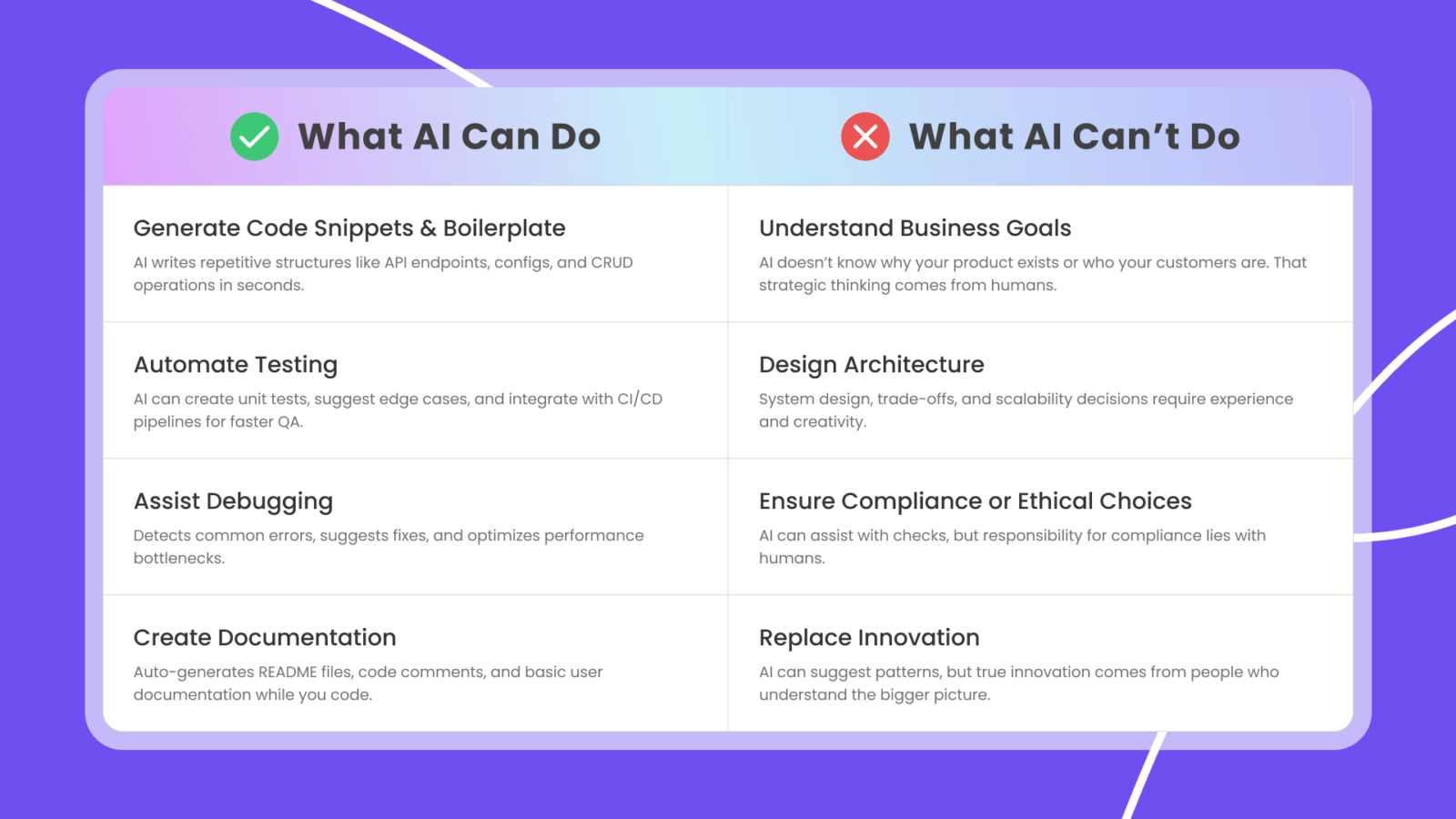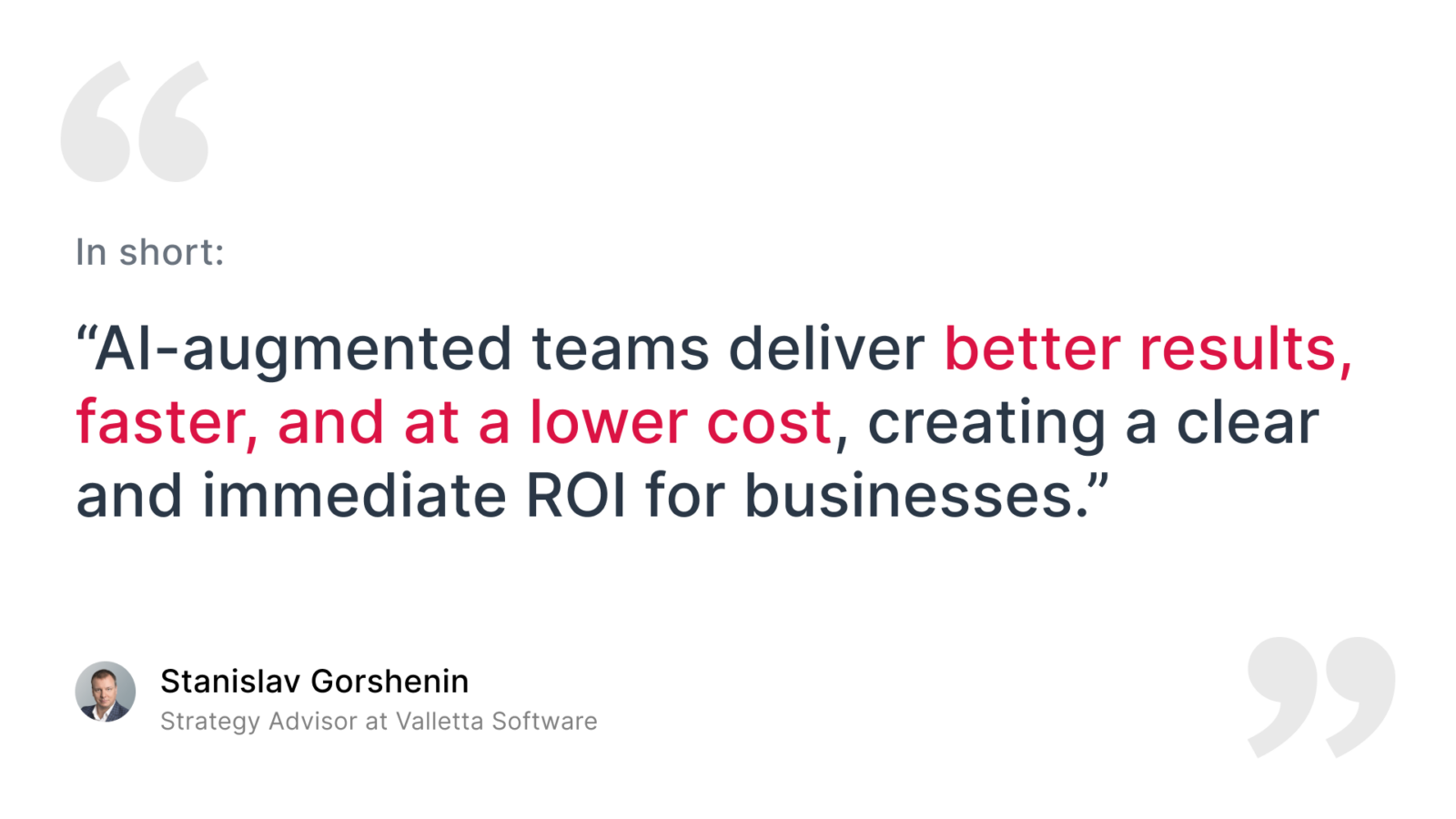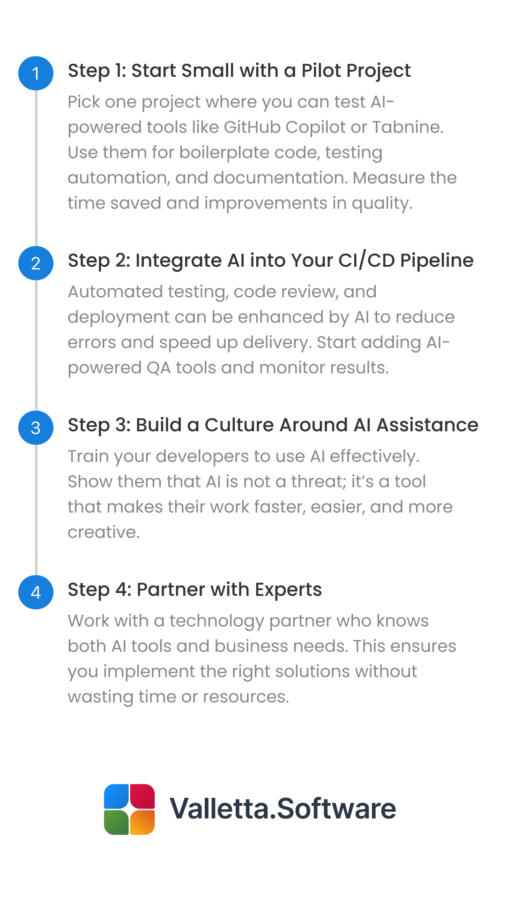AI development teams – invest now for an edge

In today’s digital-first world, software is no longer just a support function; it’s the backbone of nearly every modern business. Whether you’re launching a product, optimizing internal tools, or responding to market changes, your ability to build and adapt software quickly can make or break your growth.
But here’s the challenge: development is getting more complex, timelines are shrinking, and the global shortage of skilled engineers continues to grow. Traditional development teams are stretched thin, and doing “more with less” is a survival strategy.
That’s where AI-augmented development teams come in.
By combining human expertise with AI-powered tools, businesses can build faster, improve quality, reduce costs, and make better use of existing talent. From code generation to testing and documentation, AI helps development teams focus on what matters: solving business problems and delivering value.
In this article, we’ll explore why now is the right time to invest in AI-augmented teams, what they bring to the table, and how early adopters are already gaining a competitive edge.
What Are AI-Augmented Development Teams?
AI-augmented development teams are human software engineers enhanced by artificial intelligence tools and workflows. Instead of replacing developers, AI acts as a powerful assistant, helping teams work faster, smarter, and more efficiently.
Think of it as adding a supercharged toolbox to your development team. While developers handle strategy, architecture, and business logic, AI takes care of repetitive tasks, automates code generation, suggests fixes, and even handles documentation.
Key Features of AI-Augmented Teams:

Unlike traditional automation, these systems learn from context. They understand your coding style, the architecture, and even business rules, making their assistance highly relevant.
Why Businesses Need AI in Development Right Now
The pressure on businesses to deliver high-quality software quickly has never been greater. Market demands are changing daily, and companies that can’t keep up risk losing customers to faster, more agile competitors. AI-assisted development is a strategic necessity. Here’s why:
Speed to Market
AI helps teams deliver 30-40% faster release cycles by automating repetitive coding, generating tests, and improving CI/CD pipelines. This means:
- Faster MVP delivery for startups.
- Shorter feature release times for enterprise products.
Why it matters: The quicker you launch, the sooner you capture market share.
Cost Efficiency
Manual tasks like writing boilerplate code or repetitive testing drain resources. AI reduces these costs by:
- Automating up to 50% of routine coding tasks.
- Lowering QA efforts by generating automated tests.
- Reducing the number of bugs that reach production, saving on costly fixes.
Result: Lower development costs and better ROI.
Solving the Talent Gap
There’s a global shortage of skilled developers, and hiring top talent is expensive. AI tools amplify the productivity of existing teams, allowing them to do more without increasing headcount.
Benefit: Deliver enterprise-grade projects without waiting months to scale your team.
Competitive Advantage
Early adopters of AI-assisted development set the benchmark for speed and quality. They iterate faster, innovate more, and capture market opportunities before competitors.
Reality check: If your competitors embrace AI before you, they’ll move faster and you’ll be playing catch-up.
What AI Can (and Can’t) Do
AI brings incredible efficiency to development workflows, but it’s important to understand its limits. It is a tool, not a replacement for developers. Here’s the reality:

ROI of AI-Augmented Teams (With Numbers)
Investing in AI-augmented development teams is about measurable business impact. Here are the key performance improvements companies experience when they integrate AI into their development processes:
✅ 30-40% Faster Release Cycles
Automating routine coding and testing tasks significantly shortens development timelines.
Example: Features that took 4 weeks to build can now be shipped in 2–3 weeks.
✅ Up to 50% Less Manual QA Effort
AI-generated unit tests and regression testing cut down QA bottlenecks.
Impact: Fewer bugs slip into production, reducing post-release fixes and costs.
✅ Reduced Time-to-Market = Higher Revenue
Faster releases mean earlier product launches and revenue generation.
- For startups: Quicker MVP validation = faster investor confidence.
- For enterprises: Shorter release cycles = better customer retention.
✅ Lower Total Cost of Ownership (TCO)
By reducing manual labor and minimizing rework, AI lowers overall project costs by 15-25%.
Savings: Less time spent fixing errors, fewer delays in production, and lower operational overhead.
✅ Increased Developer Productivity & Retention
Developers spend more time on strategic and creative tasks, not repetitive work.
Benefit: Happier teams, less burnout, and reduced turnover.

Common Use Cases Across Industries
AI-augmented development teams aren’t just for tech startups. They are transforming software development across every major industry, where speed, accuracy, and scalability matter most. Let’s look at some real-world scenarios.
FinTech: Speed and Compliance in a Highly Regulated Market
Financial companies face a unique challenge: balancing innovation with compliance. Every new feature must meet strict regulations, and manual processes often lead to delays and higher costs.
AI helps by automating repetitive compliance checks, generating test cases for risk scenarios, and suggesting security best practices in real time. This means:
- Faster development of new payment features.
- Built-in compliance from day one.
- Reduced audit preparation time by 30-40%.
For banks and financial institutions, AI-assisted development is no longer a “nice-to-have”, it’s essential for staying competitive in the digital banking race.
E-Commerce: Personalization and Rapid Feature Delivery
In online retail, user expectations change overnight. Personalized shopping experiences, instant payments, and seamless checkouts are now the norm.
AI tools help developers quickly generate personalized recommendation modules, optimize search algorithms, and write code for complex pricing or promotion engines. With AI-assisted automation in testing, new features roll out in half the time, helping businesses capture seasonal opportunities before competitors.
SaaS: Continuous Delivery Without Compromise
For SaaS providers, downtime is unacceptable. Customers expect frequent updates without disruptions. AI plays a critical role by supporting continuous integration and delivery (CI/CD) pipelines. It generates tests, monitors performance, and flags potential issues before deployment, reducing release risk.
This enables SaaS companies to push updates weekly (or even daily) without sacrificing quality.
Healthcare: Secure and Compliant Applications, Faster
In healthcare, security and compliance are non-negotiable. Development teams often struggle to build applications that meet HIPAA, GDPR, and other regulations while still delivering features quickly.
AI-assisted tools can analyze code for vulnerabilities, generate secure data-handling patterns, and assist in creating audit-ready documentation. This means healthcare organizations can launch patient-facing apps in months instead of a year, without putting sensitive data at risk.
Whether you’re building financial systems, e-commerce platforms, SaaS products, or healthcare applications, AI-augmented development teams help you move faster, stay compliant, and outperform competitors.
The Risks of Waiting
Adopting AI-augmented development is becoming a necessity for survival in today’s competitive market. Businesses that delay the move risk falling behind in ways that are hard to recover from. Here’s why:
Competitors Will Outpace You
Companies that integrate AI into their development process can deliver features 30–40% faster. This means they release products sooner, respond to market changes instantly, and grab customer attention while others are still coding. If you’re not moving at the same speed, you’re already losing ground.
Development Costs Will Keep Rising
Manual processes and long release cycles translate into higher costs. The longer you stick to traditional development, the more money you spend on repetitive tasks, bug fixes, and delayed launches. By the time you implement AI, your competitors will have reduced their costs and reinvested the savings in innovation.
Talent Retention Will Become Harder
Top developers want modern tools. They don’t want to waste time writing boilerplate code or running repetitive tests. Teams that lack AI assistance often face burnout, low morale, and higher turnover. Companies that embrace AI create a more efficient and engaging environment, attracting and retaining the best talent.
Innovation Will Slow Down
If your team is busy fighting with legacy processes, they have less time to innovate. This means fewer new features, slower response to customer needs, and limited ability to scale. In contrast, AI-augmented teams free up time for strategic work and creative problem-solving.
Waiting doesn’t just delay progress; it amplifies your risks. Competitors adopting AI now are building a permanent advantage. The question is not if you should adopt AI-assisted development, but how soon can you start?
How to Get Started
The good news is that adopting AI-augmented development isn’t as complex as it sounds. You don’t need to reinvent your entire process overnight. Here’s a simple roadmap to make the transition smooth and effective:

Ready to accelerate your development?
The businesses that win tomorrow are the ones that invest in AI-augmented development today. Our team at Valletta Software helps companies build faster, smarter, and better, leveraging AI to achieve real business results.
✅ Cut release times by 30-40%.
✅ Reduce QA effort by up to 50%.
✅ Improve team efficiency and morale.
Don’t wait for your competitors to take the lead. Start now.